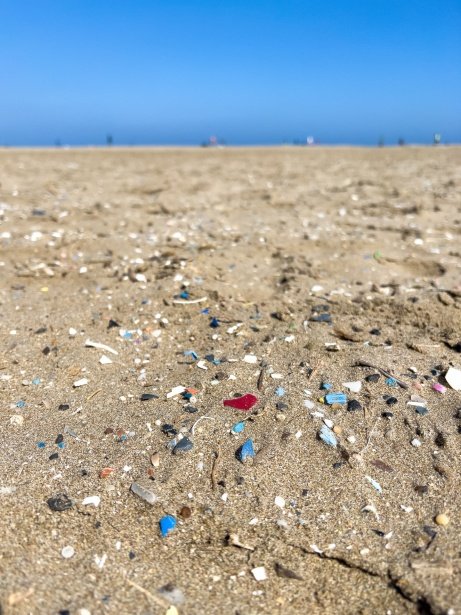Microplastic Pollution Destroying the Arctic and Water life
Reading that the arctic is a place that is battled with microplastic pollution makes me wonder how they got there at the first instance. When I visualize the arctic, I see it as a place with clear blue skies filled with ice and ocean waters but not a place where some of the worst microplastic pollution exists. So you might want to ask how these plastics get there.

Public Dormain
The arctic is the least densely population region in the world so they cannot be consuming that much plastic but when we look at the total plastic that find their way to the ocean from land, and there are about 19 million metric tons of plastic that find their way to water bodies annually, but then while we can see the PET bottles and bags in water, we also find microplastics in water.
These plastics are anything smaller than 5mm in diameter but then you ask how we get this plastics in the water? Well, I will give you an example; when you wash your synthetic fabric clothes, there are tiny pieces of the fabric that break off to pollute the drain which then goes down the water. Even Big plastics can become microplastics over time but then you see fishermen are also responsible for a lot of microplastics in the oceans and this is because they dump gears into the oceans. This derelict gears like nets break down to become tiny microplastics.
Since microplastic is as a result of plastic breakdown, you will be surprised to know that this waste isn't found in places where there are a lot of people dwell ironically. This waste are found in polar regions making the arctic to have the highest number of microplastic. This wastes are not only in the water body, but also in the solid ice around there. The type of microplastic waste found in the arctic isn't one that is associated with water body alone but from distant sources brought to that region through ocean currents, and floating raft of Ice.
The origin of this plastics an be very difficult to identify but then it looks like all road of wastes lead to the arctic and it is not like living organisms are also not affected by microplastics, it has been found in seabirds, marine worms, fishes, and so on but then we need to look to stopping plastic waste from getting to our water. Addressing this issue requires a multifaceted approach such as proper plastic waste management would help, using biodegradable fishing net will also reduce the presence of these microplastics there, and recycling. Although this is not a final way to stop this waste from getting into our water bodies but with this, we can save a lot of animals, as well as our water body.
While these measures may not entirely eradicate the problem, they represent important strides toward safeguarding our water bodies and protecting vulnerable Arctic ecosystems from the harmful effects of microplastic pollution. By collectively addressing the root causes of plastic pollution, we can work towards preserving the integrity of our oceans and the diverse life they support.
Read More
https://www.ncbi.nlm.nih.gov/pmc/articles/PMC4597356/
https://www.sciencedirect.com/science/article/abs/pii/S2452223620301395
https://www.nature.com/articles/s43017-022-00279-8
https://www.sciencedirect.com/science/article/pii/S0025326X20309413?via%3Dihub
https://www.ncbi.nlm.nih.gov/pmc/articles/PMC10328408/
https://www.sciencedirect.com/science/article/abs/pii/S0360544219315464
https://pubs.acs.org/doi/10.1021/acs.est.9b06981
https://www.mdpi.com/2079-6439/7/4/32
https://agupubs.onlinelibrary.wiley.com/doi/full/10.1002/2014EF000240
https://www.nature.com/articles/s41467-018-03825-5

Thank you for shedding light on this crucial issue! It's truly disheartening to learn about the extent of microplastic pollution in the Arctic and its devastating effects on marine life.
Your explanation of how these plastics find their way into such remote regions is eye-opening. How do you think we can raise awareness and encourage action to address this urgent environmental threat?
Thanks a lot for reading. You see, when it comes to awareness, several organizations are doing their bests but then it can be difficult to see people follow guidelines especially in countries that are not developed. For instance how many people recycle stuffs in Africa, or other not developed parts of the world?
It looks like our personal activities are going to end up destroying our planet. If the sources of the microplastics are properly investigated, we might be shocked to see how PET makes huge percentage.
These companies are doing more harm than good with PET but it looks like they aren't willing to change it so they have decided to add the recycle logo to their bottles but they do not follow up to ensure that people do as they say.
Thanks for your contribution to the STEMsocial community. Feel free to join us on discord to get to know the rest of us!
Please consider delegating to the @stemsocial account (85% of the curation rewards are returned).
Thanks for including @stemsocial as a beneficiary, which gives you stronger support.
Es demasiado real esto y debería tener más visibilidad. Hace poco ví una noticia que nos decía que los osos polares estaban enfrentado una situación complicada y es que por causa de la prolongación del verano están sufriendo las consecuencias de todos los disturbios que causamos nosotros y las industrias. Leí que estaban bajando alrededor de un Kg por dia